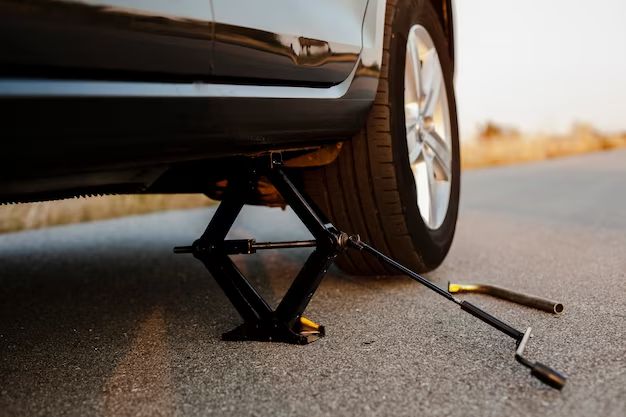Many truck owners choose to lift or level their trucks for greater ground clearance and a more rugged look. This can require upgrading to larger tires as well. When it’s time to change a tire or perform other maintenance underneath the vehicle, you need the right equipment to safely jack up a lifted truck. So do you need a special jack for a lifted truck?
The short answer is yes: You do need a special jack designed for lifted trucks in order to safely support the vehicle’s weight while changing a tire or accessing the underside. The larger tires and increased ground clearance of a lifted truck means you need a jack with a greater lifting range and weight capacity than a standard floor jack.
Page Contents
Factors that Determine Proper Jack Type
There are a few important factors that determine what type of jack you need for a lifted truck:
Lift Height
How much your truck is lifted affects how high you need to be able to safely jack it up. For example, a truck lifted 6 inches requires a jack that can lift at least that height. The jack needs to lift the vehicle enough to completely raise the tire off the ground.
Suspension Type
The suspension on your lifted truck also matters when selecting a jack. If you have a solid front axle suspension, you need a jack meant for that, as opposed to an independent front suspension. Bottle jacks work well for solid axle lifted trucks.
Weight
You need a jack with sufficient weight capacity for your truck’s curb weight plus any additional cargo or gear. Heavy duty jacks built for lifted trucks have weight capacities up to 12,000 pounds or more. Exceeding a jack’s weight rating can cause it to fail or collapse when lifting.
Jack Types for Lifted Trucks
There are a few specialized jack types built for safely lifting lifted trucks to change tires or access the underside of the vehicle:
Hi-Lift Jack
Also called a farm jack, this versatile jack can be used both on and off-road. It uses a long steel handle that lets you pump the jack to maximum lifting height. Hi-lift jacks can lift lifted trucks 3-4 feet in the air.
Bottle Jack
This hydraulic jack has a cylinder in the shape of a bottle. You use a handle to pump the jack, applying hydraulic pressure. Bottle jacks for lifted trucks have increased weight capacities and lift heights compared to standard models.
Floor Jack
For lifted trucks, a heavy duty floor jack with an extended lifting range of up to 30 inches works well. Make sure to get one rated for your truck’s weight. You’ll need jack stands too, for safety when getting under the truck.
Air Jack
Air-hydraulic jacks use air pressure to raise the lifting arm. They make it fast and easy to jack up a lifted truck since you don’t have to manually pump the jack. You do need an air compressor.
| Jack Type | Lifting Range | Weight Capacity |
|---|---|---|
| Hi-Lift Jack | 36 – 60 inches | Up to 7,000 pounds |
| Bottle Jack | 8 – 24 inches | Up to 20,000 pounds |
| Floor Jack | 15 – 30 inches | Up to 12,000 pounds |
| Air Jack | 5 – 29 inches | Up to 12,000 pounds |
Lifting and Support Points on Lifted Trucks
It’s critical to properly place jack stands when lifting a vehicle. For lifted trucks, here are the recommended support points:
Front Axle
Place jack stands under the front axle on either side when jacking up the front end of a lifted truck, not under the frame. This provides stability on solid axle suspensions. Use wheel chocks to prevent rolling.
Frame Rail
You can position jack stands under the frame rail to support the rear of a lifted truck. Make sure the bases sit solidly on a flattened surface and the stands clear the exhaust.
Unibody Pinch Weld
For lifted unibody trucks, position jack stands under the pinch weld flanges on either side. These reinforced areas are designed as vehicle support points. Stack blocks if needed for proper stand height.
Safety Tips for Lifting Lifted Trucks
Safety should be your top priority when jacking up a lifted truck. Keep these important tips in mind:
– Only use a jack on solid, level ground with the parking brake engaged
– Block the wheels both in front and behind the wheels being lifted
– Check that jack stand bases are solid and stands are rated for truck weight
– Lift to a height just enough to raise tires off the ground
– Support with properly positioned jack stands before getting underneath
– Never rely solely on a hydraulic jack to support a lifted vehicle
Taking the time to use the right jacking points and stands will keep the heavy truck stable and help prevent accidents or injuries.
Conclusion
Lifting your truck gives it great off-road capability and style, but it requires special equipment for maintenance procedures like tire changes. Investing in a quality high-lift floor jack, bottle jack, hi-lift jack, or air jack will allow you to safely raise your truck to change tires or access the underside. Make sure to select a jack designed specifically for lifted trucks, with appropriate lift height for your truck and weight capacity. And don’t forget good jack stands to support the truck once lifted. Following proper lifting and support procedures will keep you safe during your lifted truck maintenance and repairs.
